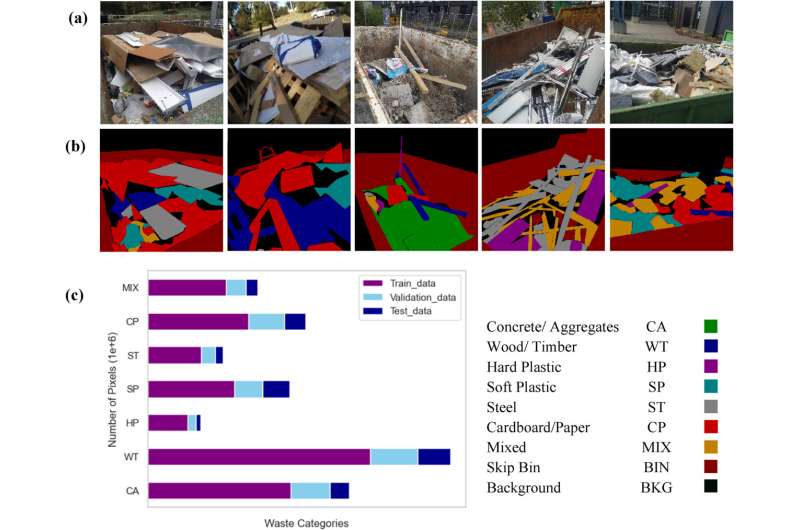This article has been reviewed according to Science X's editorial process and policies. Editors have highlighted the following attributes while ensuring the content's credibility:
fact-checked
peer-reviewed publication
trusted source
proofread
Research unlocks potential to revolutionize construction waste recycling

There was no time to waste as researchers trawled through skip bins across Melbourne construction sites, capturing hundreds of photos of materials destined for landfill.
Now, in new research published in the Journal of Environmental Management that could revolutionize the way construction waste materials are processed and recycled, they used the images to train deep learning (DL) and artificial intelligence (AI) to recognize vast array of materials and particles in mixed waste that comes from construction sites.
Led by Monash Ph.D. candidate Diani Sirimewan, from the Automation and Sustainability in Construction and Intelligent Infrastructure (ASCII) Lab in Civil Engineering, the study paves the way for the use of advanced robotics and automation for construction waste processing, which currently relies on workers to manually pick through dangerous and potentially contaminated waste.
The computer-based system can identify and categorize recyclable materials more accurately and efficiently than human workers and is even capable of detecting contaminants, which can pose risks to the community and the environment as seen in the investigation into asbestos-contaminated garden mulch found recently in Sydney parklands.
While many of the materials such as timber and glass are potentially recyclable, sorting debris from demolition and construction sites is complex and challenging, and significant advances have been limited to domestic waste that cannot distinguish between multiple cluttered waste items.
Sirimewan believes her research is the first to capture detailed images of dense CRD waste inside bins on construction sites, enabling her to build significantly advanced recognition and detection models capable of recognizing waste that is almost completely buried among other rubbish and tiny contaminant particles.
Sirimewan is working closely with colleagues who are trialing the technology using simulation with robotic arms and hopes it will spur investment in robotics R&D and automation to improve the efficiency of construction waste processing and recycling in Australia.
"Our deep learning models showed the remarkable ability to recognize the composition of construction and demolition waste streams, including the identification of contaminants," Sirimewan said.
"It's exciting. The technology could significantly reduce the volume of waste sent to landfills through better-quality recycling—benefiting the environment and reducing the need for workers to be exposed to dangerous and toxic materials.
"We are continually refining our models for application in new robotic technologies and working closely with colleagues who are trialing it through the simulation of robotic arms."
Sirimewan said Australia urgently needs construction waste recycling plants.
"With the volume of landfill from construction waste expected to balloon, its effective management is a growing problem," Sirimewan said.
"Investment in the entire construction waste management ecosystem supports a circular economy, job creation, manufacturing opportunities and market development opportunities for recycled products."
Head of the ASCII Lab, Associate Professor Mehrdad Arashpour, said it is in the national interest to support the innovation of much-needed solutions to the growing waste management problem.
"Every time we demolish or renovate a building or construct something new, a huge amount of waste material is generated," Arashpour said.
"Currently, most of these materials go to waste and end up in landfill, which has significant environmental impacts, not to mention the loss of potentially reusable resources and economic costs."
More information: Diani Sirimewan et al, Deep learning-based models for environmental management: Recognizing construction, renovation, and demolition waste in-the-wild, Journal of Environmental Management (2024). DOI: 10.1016/j.jenvman.2023.119908

















